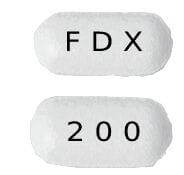Uses
Fidaxomicin is used to treat diarrhea caused by Clostridium difficile (C. difficile; a type of bacteria that may cause severe or life-threatening diarrhea) in adults and children 6 months of age and older. Fidaxomicin is in a class of medications called macrolide antibiotics. It works by killing bacteria in the intestines.
Fidaxomicin will not treat infections in any other part of the body. Antibiotics such as fidaxomicin will not work for colds, flu, or other viral infections. Taking antibiotics when they are not needed increases your risk of getting an infection later that resists antibiotic treatment.
Side Effects Of Fidaxomicin
Fidaxomicin may cause side effects. Tell your doctor if any of these symptoms are severe or do not go away:
- nausea
- vomiting
- stomach pain
- constipation
Some side effects can be serious. If you experience any of these symptoms, call your doctor immediately:
- rash
- itching
- swelling of the face, throat, tongue, lips, and eyes
- shortness of breath
- difficulty breathing or swallowing
- weakness
- fatigue
- dizziness
- headache
- chest pain
- fast, pounding heartbeat
- pale skin
- cold hands and feet
- stomach cramps
- bright red blood in vomit
- vomit that looks like coffee-grounds
- black, tarry stools
- bright red blood in stools
- fever, sore throat, chills, or other signs of infection
Fidaxomicin may cause other side effects. Call your doctor if you have any unusual problems while taking this medication.
Warnings & Precautions
Before taking fidaxomicin:
- tell your doctor and pharmacist if you are allergic to fidaxomicin, azithromycin (Zithromax), clarithromycin (Biaxin, in Prevpac), erythromycin (E.E.S., ERY-C, Erythrocin), telithromycin (Ketek; not available in the U.S.), any other medications, or any of the ingredients in fidaxomicin tablets or suspension. Ask your pharmacist for a list of the ingredients.
- tell your doctor and pharmacist what other prescription and nonprescription medications, vitamins, nutritional supplements, and herbal products you are taking or plan to take. Your doctor may need to change the doses of your medications or monitor you carefully for side effects.
- tell your doctor if you have or have ever had any medical condition.
- tell your doctor if you are pregnant, plan to become pregnant, or are breast-feeding. If you become pregnant while taking fidaxomicin, call your doctor.
Fidaxomicin Dosage
Fidaxomicin comes as a tablet and as a suspension (liquid) to take by mouth. It is usually taken with or without food two times a day (approximately 12 hours apart) for 10 days. Take fidaxomicin at around the same times every day. Follow the directions on your prescription label carefully, and ask your doctor or pharmacist to explain any part you do not understand. Take fidaxomicin exactly as directed. Do not take more or less of it or take it more often than prescribed by your doctor.
Take the suspension bottle out of the refrigerator 15 minutes before preparing your dose. Shake the suspension well before each use to mix the medication evenly. Use an oral syringe to measure the correct amount of medication. Do not use a household spoon to measure your dose.
You should begin to feel better during the first few days of treatment with fidaxomicin. If your symptoms do not improve or get worse, call your doctor.
Take fidaxomicin until you finish the prescription, even if you feel better. If you stop taking fidaxomicin too soon or skip doses, your infection may not be completely treated and the bacteria may become resistant to antibiotics.
Ask your pharmacist or doctor for a copy of the manufacturer’s information for the patient.
Other
Keep all appointments with your doctor.
Do not let anyone else take your medication. Your prescription is probably not refillable. If you still have symptoms of infection after you finish the fidaxomicin, call your doctor.
It is important for you to keep a written list of all of the prescription and nonprescription (over-the-counter) medicines you are taking, as well as any products such as vitamins, minerals, or other dietary supplements. You should bring this list with you each time you visit a doctor or if you are admitted to a hospital. It is also important information to carry with you in case of emergencies.
Source
All information has been provided courtesy of MedLinePlus from the National Library of Medicine and from the FDA.



